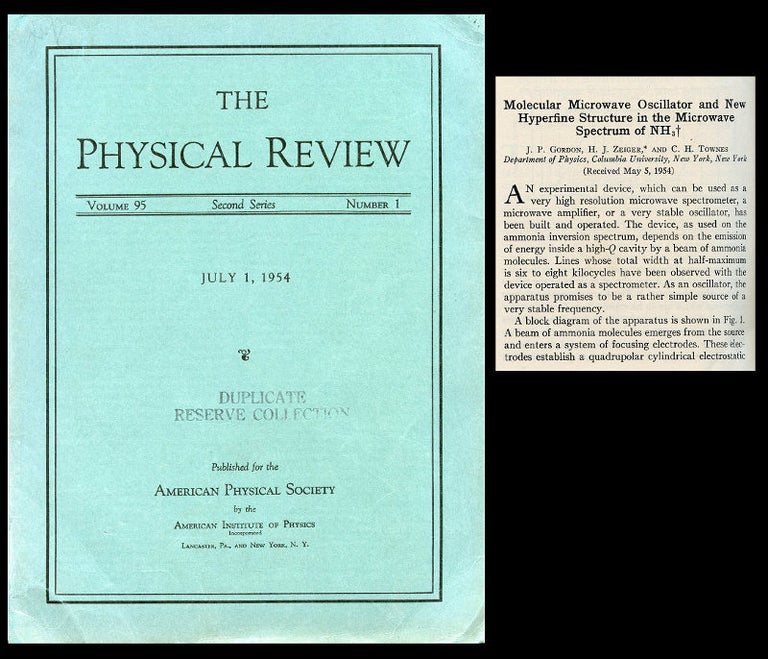Molecular Microwave Oscillator and New Hyperfine Structure in the Microwave Spectrum + Van Hove, Léon. Correlations in Space and Time and Born Approximation Scattering in Systems of Interacting Particles in Physical Review 95, Number 1, July 1, 1954, pp. 282-284; pp.249-262
Lancaster: American Physical Society, 1954. 1st Edition. FIRST EDITION IN ORIGINAL PAPER WRAPS OF THE NOBEL PRIZE WINNING CONSTRUCTION OF THE FIRST AMPLIFICATION AND GENERATION OF ELECTROMAGNETIC WAVES BY STIMULATED EMISSION -- THE FIRST AMMONIA MASER. Townes coined the word 'maser' for this device, an acronym for microwave amplification by stimulated emission of radiation. The device they built "used stimulated emission in a stream of energized ammonia molecules to produce amplification of microwaves at a frequency of about 24.0 gighertz" (Wikipedia). "Einstein suggested 'that under the proper circumstances, atoms could release excess energy as light -- either spontaneously or when stimulated by light. In 1951, Charles H. Townes, then at Columbia University in New York City, thought of a way to generate stimulated emission at microwave frequencies. "In the 1930s scientists could have built a laser. They had the optical techniques and theoretical knowledge -- but nothing pushed these together... Charles Townes od Columbia University had studies molecules as a physicist in the 1930s, and during the war he had worked on radar as an electronics engineer. The Office of Naval Research pressed him and other physicists to put their heads together and invent a way to make powerful beams of radiation at ever shorter wavelengths. In 1951 he found a solution. Under the right conditions -- say, inside a resonating cavity like the ones used to generate radar waves --- the right kind of collection of molecules might generate radiation all on its own. He was applying an engineer's insights to a physicists's atomic systems. Townes gave the problem to Herbert Zeiger, a postdoctoral student, and James P. Gordon, a graduate student. By 1954 they had the device working [this paper being the detailed description of what they built]. Townes called it a MASER, for "Microwave Amplification by Stimulated Emission of Radiation" (AIP, Laserfest). Townes was awarded the Nobel Prize in Physics for this work in 1964. ALSO INCLUDED is Van Hove's paper presenting a central quantity in the study of fluctuations, the density-density spacetime correlation that has come to be known as the Van Hove function. Item #390
CONDITION & DETAILS: Lancaster: American Physical Society. Quarto (11.25 x 8.25 inches; 275 x 200mm). Original wraps. Ex-libris bearing a light "Duplicate Reserve Collection" stamp on the front wrap and two equally light small date stamps on the rear wrap. Minor wear at the spine, repaired to match. Slight scuffing and wear around the edges. Otherwise bright and very clean throughout.
Price: $800.00

